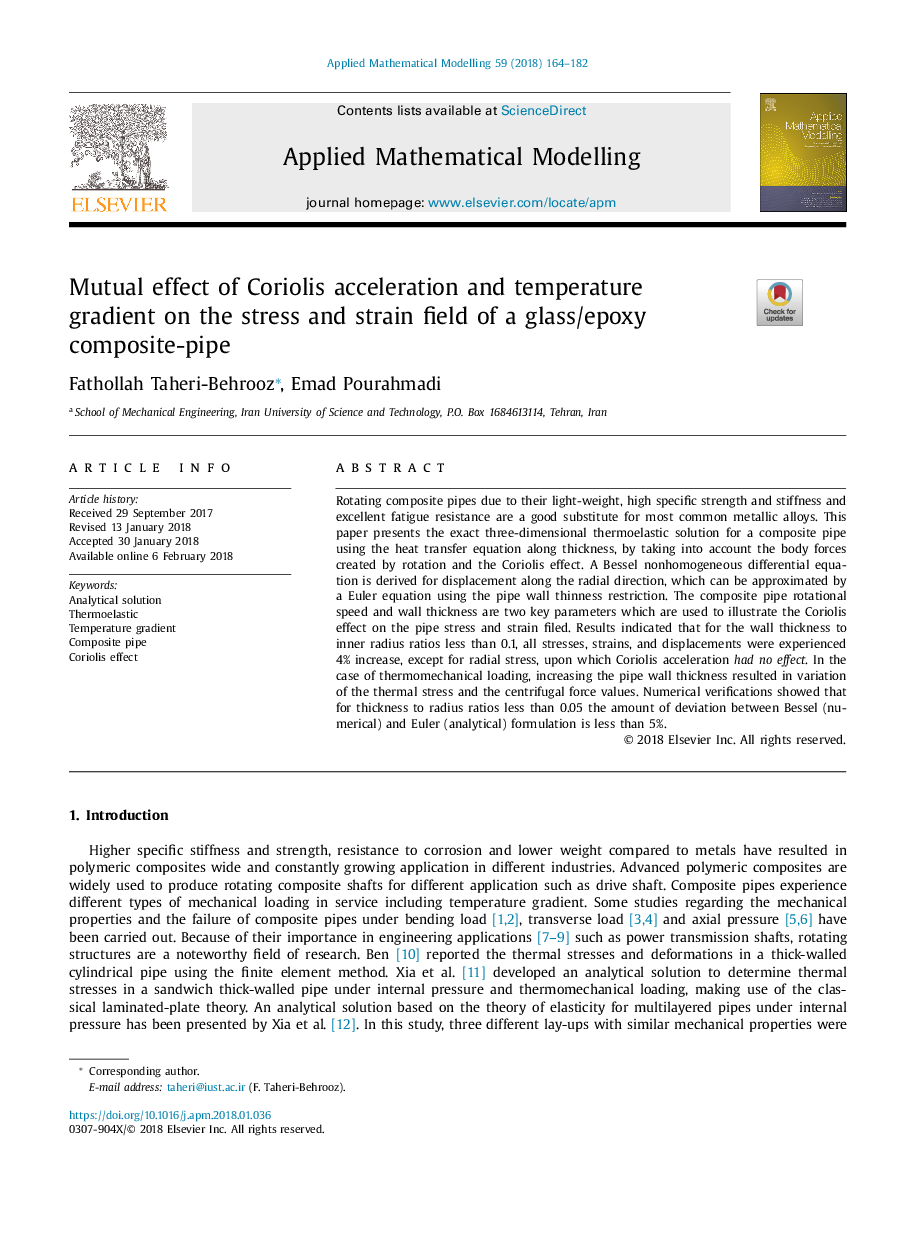| کد مقاله | کد نشریه | سال انتشار | مقاله انگلیسی | نسخه تمام متن |
|---|---|---|---|---|
| 8051559 | 1519374 | 2018 | 19 صفحه PDF | دانلود رایگان |
عنوان انگلیسی مقاله ISI
Mutual effect of Coriolis acceleration and temperature gradient on the stress and strain field of a glass/epoxy composite-pipe
ترجمه فارسی عنوان
اثر متقابل شتاب کریوولیس و گرادیان درجه حرارت در زمینه تنش و کرنش لوله کامپوزیت شیشه ای / اپوکسی
دانلود مقاله + سفارش ترجمه
دانلود مقاله ISI انگلیسی
رایگان برای ایرانیان
کلمات کلیدی
راه حل تحلیلی، ترموالاستیک، شیب درجه حرارت، لوله کامپوزیت اثر کریوولیس،
ترجمه چکیده
لوله های کامپوزیت چرخشی با توجه به سبک وزن، قدرت خاص و سختی خاص و مقاومت در برابر خستگی بسیار عالی، جایگزین خوبی برای فلزات معمولی هستند. این مقاله راه حل دقیق ترموالاستیک سه بعدی برای لوله کامپوزیتی را با استفاده از معادله انتقال گرما در طول ضخامت، با توجه به نیروهای بدن ایجاد شده توسط چرخش و اثر کریوولیس ارائه می دهد. یک معادله دیفرانسیل غیر همگن بسول برای جابجایی در امتداد جهت شعاعی مشتق شده است که می تواند توسط یک معادله ییلر با استفاده از محدودیت باریک دیوار لوله تقریب یابد. سرعت چرخش کامپوزیت و ضخامت دیواره، دو پارامتر کلیدی هستند که برای نشان دادن اثر کریوولیس بر تنش لوله و فشار مورد استفاده قرار می گیرند. نتایج نشان داد که برای ضخامت دیواره نسبت به شعاع داخلی کمتر از 0.1، تمام تنش ها، سویه ها و جابه جایی ها به علت استرس شعاعی، افزایش 4٪ افزایش یافته است که شتاب کریوئلیس تأثیری بر آن نمی گذارد. در مورد بارگذاری حرارتی، افزایش ضخامت دیواره لوله منجر به تغییر تنش گرما و مقادیر نیروی گریز از مرکز می شود. بررسی های عددی نشان داد که برای ضخامت نسبت به شعاع کمتر از 05/0 مقدار انحراف بین فرمول بسل (عددی) و ایلر (تحلیلی) کمتر از 5٪ است.
موضوعات مرتبط
مهندسی و علوم پایه
سایر رشته های مهندسی
مکانیک محاسباتی
چکیده انگلیسی
Rotating composite pipes due to their light-weight, high specific strength and stiffness and excellent fatigue resistance are a good substitute for most common metallic alloys. This paper presents the exact three-dimensional thermoelastic solution for a composite pipe using the heat transfer equation along thickness, by taking into account the body forces created by rotation and the Coriolis effect. A Bessel nonhomogeneous differential equation is derived for displacement along the radial direction, which can be approximated by a Euler equation using the pipe wall thinness restriction. The composite pipe rotational speed and wall thickness are two key parameters which are used to illustrate the Coriolis effect on the pipe stress and strain filed. Results indicated that for the wall thickness to inner radius ratios less than 0.1, all stresses, strains, and displacements were experienced 4% increase, except for radial stress, upon which Coriolis acceleration had no effect. In the case of thermomechanical loading, increasing the pipe wall thickness resulted in variation of the thermal stress and the centrifugal force values. Numerical verifications showed that for thickness to radius ratios less than 0.05 the amount of deviation between Bessel (numerical) and Euler (analytical) formulation is less than 5%.
ناشر
Database: Elsevier - ScienceDirect (ساینس دایرکت)
Journal: Applied Mathematical Modelling - Volume 59, July 2018, Pages 164-182
Journal: Applied Mathematical Modelling - Volume 59, July 2018, Pages 164-182
نویسندگان
Fathollah Taheri-Behrooz, Emad Pourahmadi,
